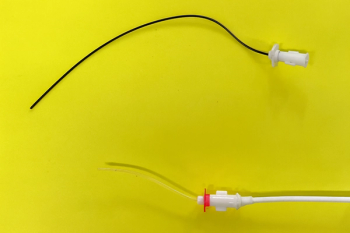
Canine urolith update, 2009: Perspectives from the Minnesota Urolith Center
Investigating the changes in composition over the last couple of decades.
Knowledge of the mineral composition of uroliths is important because contemporary methods of detection, treatment and prevention of the underlying causes of urolithiasis are primarily related to knowledge of urolith composition. This discussion is based on quantitative analysis of 47,036 canine uroliths submitted to the Minnesota Urolith Center in 2009.
Dr. Carl A. Osborne
In 1981, calcium oxalate was detected in only 5 percent of canine uroliths submitted to the Minnesota Urolith Center, whereas struvite (magnesium ammonium phosphate) was detected in 78 percent. However, evaluation of the prevalence of different types of minerals in canine uroliths during successive years revealed a gradual and consistent increase in occurrence of calcium oxalate uroliths and a gradual and consistent decline in the occurrence of struvite uroliths (Figure 1, p. 14S). In fact, by 2003 the prevalence of calcium oxalate (41 percent) was approximately equal to struvite (40 percent).
In 2004, calcium oxalate (41 percent) surpassed struvite (39 percent). In 2005, calcium oxalate was detected in 41 percent of the urolith submissions, while struvite was detected in 38 percent. In 2009, the frequency of occurrence of calcium oxalate (41 percent) and struvite (39 percent) remained about the same (Table 1; Figures 1, 2 & 3, p. 14S). Recall that the frequency of feline calcium oxalate and struvite occurrence during the same period was similar. (For additional details related to feline uroliths and feline urethral plugs, see "Epidemiology of feline uroliths and urethral plugs: Update 1981 to 2009" in the June 2010 issue of DVM Newsmagazine.) Why should we care?
Table 1
Risk and protective factors
What is the underlying reason for the gradual but dramatic change in the mineral composition of canine uroliths? Although several hypotheses have been proposed to explain this phenomenon, to date none have been proved. Available evidence suggests an interaction between 1) demographic risk factors such as breed, age, gender, anatomy and genetic predisposition and 2) environmental risk factors such as sources of food, water, exposure to certain drugs and living conditions. Some factors may increase the risk for urolith formation, and some factors may be protective.
Figure 1: MAP = Magnesium ammonium phosphate, or struvite; CaOx = calcium oxalate; Capoh = calcium phosphate.
Please note that not all risk and protective factors are of equal importance. It is apparent that each contributing risk or protective factor may play a limited or a significant role in the pathogenesis of urolithiasis. The chance of developing a specific type of urolith when exposed to one or more risk or protective factors is often expressed in terms of numerical probabilities (so-called odds or odds ratios).
Figure 2: MAP = Magenesium ammonium phosphate, or struvite; CaOx = calcium oxalate; CaPO4 = calcium phosphate; Cmpd = compound.
When used in a qualitative rather than quantitative way, the significance of risk or protective factors should not be assigned an "all or none" or "always or never" interpretation. In many situations, each risk factor contributes a limited role to the development of urolithiasis. In fact, in some situations, they may not be a factor in every exposed patient. Furthermore, identifying one event in a chain of etiologic events is not the same as identifying the entire etiologic chain.
Figure 3: MAP = Magenesium ammonium phosphate, or struvite; CaOx = calcium oxalate; CaPO4 = calcium phosphate; Cmpd = compound.
Why identify risk and protective factors?
Our interest in recognizing the association of specific risk and protective factors with urolithiasis is related to 1) identifying healthy but susceptible populations of animals and trying to minimize their exposure to these risk factors, 2) identifying healthy but susceptible populations and trying to enhance their exposure to protective factors and 3) facilitating detection and treatment of subclinical urolithiasis that has already developed in susceptible patients.
With support of an educational gift from Hill's Pet Nutrition, studies are in progress at the Minnesota Urolith Center to identify risk and protective factors associated with calcium oxalate, struvite, urate, cystine, calcium phosphate and silica uroliths in dogs and cats. To learn more about our studies and how you can participate in them, visit our Web site at
Dr. Osborne, a diplomate of the American College of Veterinary Internal Medicine, is professor of medicine in the Department of Small Animal Clinical Sciences, College of Veterinary Medicine, University of Minnesota.
Newsletter
From exam room tips to practice management insights, get trusted veterinary news delivered straight to your inbox—subscribe to dvm360.





